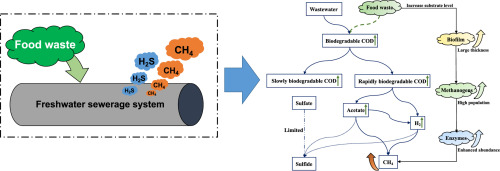Water Research ( IF 11.4 ) Pub Date : 2020-02-12 , DOI: 10.1016/j.watres.2020.115616 Feixiang Zan , Ji Dai , Feng Jiang , George A. Ekama , Guanghao Chen

|
Emission of sulfide and methane from sewerage system has been a major concern for a long time. Sewers are now facing emerging challenges, such as receiving food waste (FW) to relieve the burdens on solid waste treatment. However, the knowledge of the direct impact of FW addition on sulfide and methane production in and emission from sewers is still lacking. In this study, two lab-scale sewer reactors, one without and one with FW addition, were continuously operated to investigate the production of sulfide and methane and microbial communities arising from FW discharge to freshwater sewerage system. The 190-day long-term monitoring and the batch tests on days 69 and 124 suggest that the FW addition has little impact on sulfide production possibly due to the limited sulfate concentration (40 mg S/L) but enhanced methane production by up to 60%. Moreover, cryosection-fluorescence in situ hybridization (FISH) revealed that the FW addition significantly stimulated the accumulation of methanogenic archaea (MA) in sewer biofilms and altered the spatial distributions of sulfate-reducing bacteria (SRB) and MA. Moreover, the relative abundance of MA in biofilms with FW addition was higher than that without FW addition, whereas the relative abundance of SRB was similar. Metabolic pathway analysis for sulfidogenesis and methanogenesis indicates that sufficient substrates derived from the FW addition were biodegraded during fermentation to produce acetate and hydrogen, and consequently facilitate methanogenesis. These findings shed light on the impacts of changes in wastewater compositions (e.g., FW addition) on sulfide and methane production in the freshwater sewerage system for improved policy-making on sewer management.
中文翻译:

将食物残渣排入下水道可提高甲烷排放量:实验室规模的调查
长期以来,污水处理系统中硫化物和甲烷的排放一直是人们关注的主要问题。下水道目前正面临新的挑战,例如接收食物垃圾(FW)以减轻固体垃圾处理的负担。但是,仍然缺乏关于添加固件对下水道中的硫化物和甲烷生产以及排放的直接影响的知识。在这项研究中,连续运行了两个实验室规模的下水道反应堆,其中一个没有反应堆,一个增加了FW,以调查由FW排放到淡水污水处理系统而产生的硫化物和甲烷以及微生物群落。190天的长期监控以及第69和124天的分批测试表明,FW的添加对硫化物的生产几乎没有影响,这可能是由于硫酸盐浓度有限(40 mg S / L),但甲烷的生产最多增加了60 %。原位杂交(FISH)表明,添加FW显着刺激了下水道生物膜中产甲烷菌(MA)的积累,并改变了减少硫酸盐还原细菌(SRB)和MA的空间分布。此外,添加FW的生物膜中MA的相对丰度高于不添加FW的生物膜中的MA,而SRB的相对丰度相似。硫化物生成和甲烷生成的代谢途径分析表明,在发酵过程中,从FW添加物中衍生的足够底物会被生物降解以产生乙酸盐和氢气,从而促进甲烷生成。这些发现揭示了废水成分的变化(例如添加FW)对淡水污水处理系统中硫化物和甲烷生产的影响,从而改善了污水处理管理的政策制定。











































 京公网安备 11010802027423号
京公网安备 11010802027423号